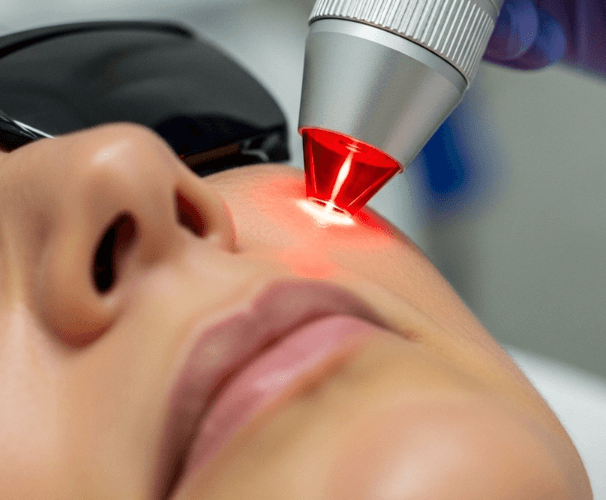Treatment Overview
The Q-Switched Ruby Laser (694 nm) is one of the earliest pigment-targeting lasers, with high absorption by melanin. It delivers nanosecond pulses to fragment melanin clusters, allowing the body’s natural processes to clear them.
In Korea, the Q-Switched Ruby Laser is sometimes used for freckles removal, especially in cases where freckles are dense, resistant, or accompanied by congenital pigmentation (like café-au-lait spots). However, because Ruby lasers carry a higher risk of post-inflammatory hyperpigmentation (PIH) in Asian skin, they are generally applied cautiously or in combination with other treatments like Nd:YAG or Pico lasers.
It belongs to the Pigmentation Treatment family (Ruby, Alexandrite, Nd:YAG, Dual Toning, Pico Lasers, Fraxel Dual, Clear + Brilliant, Carbon Peel, CO₂):
- Ruby (694 nm): Best for stubborn freckles + congenital pigment.
- Alexandrite (755 nm): Best for resistant freckles + deeper pigment.
- Nd:YAG (1064/532 nm): Best for dermal + epidermal freckles.
- Dual Toning: Best for freckles with mixed-depth pigment.
- Pico Lasers: Best for resistant freckles + PIH with lower risks.
- Fraxel Dual: Best for freckles + sun damage + texture.
- Clear + Brilliant: Best for mild freckles or prevention.
- Carbon Peel: Best for freckles + oil control + brightening.
- CO₂ Fractional: Best for freckles + scars/texture repair.
Purpose & Benefits
- Freckles Clearance: Breaks down superficial pigmented lesions.
- Strong Melanin Targeting: High melanin absorption makes it effective for darker freckles.
- Comprehensive Pigment Care: Useful for freckles plus other pigment disorders.
- Long-Lasting Results: Reduces stubborn freckles when combined with sun protection.
- Combination Therapy: Often layered with Pico or Nd:YAG to reduce PIH risks.
Ideal Candidates
Q-Switched Ruby Laser in Korea is recommended for:
- Adults with stubborn or resistant freckles.
- Patients with dense freckles + congenital pigmentation.
- Individuals who did not respond to milder treatments like IPL or Clear + Brilliant.
Treatment Comparison:
- Ruby: Best for resistant freckles, but higher PIH risk.
- Nd:YAG: Best for freckles with deeper dermal pigment.
- Dual Toning: Best for freckles across multiple layers.
- Pico Lasers: Best for freckles with minimal PIH risk.
- Fraxel Dual: Best for freckles + sun damage + aging.
- Clear + Brilliant: Best for mild freckles and maintenance.
- Carbon Peel: Best for freckles + glow + oily skin.
Possible Risks & Complications
The Ruby Laser is effective but comes with higher PIH risk, especially in Asian skin:
- Redness & Warmth: Temporary, resolves in 1–2 days.
- Temporary Darkening: Freckles may darken before flaking.
- Crusting/Peeling: Natural part of healing.
- PIH (Post-Inflammatory Hyperpigmentation): Higher risk vs Pico/Nd:YAG.
- Rare Risks: Hypopigmentation or mottling.
Surgical Techniques Used
- 694 nm Wavelength: Strong melanin absorption for freckles.
- Nanosecond Pulses: Shatters melanin clusters for natural clearance.
- Combination Use: Often paired with Nd:YAG or Pico for safer outcomes.
- Protocol: 2–4 sessions spaced 4–6 weeks apart; cautious fluence for Asian skin.
Recovery & Aftercare
- Immediately: Mild redness or swelling.
- 2–5 Days: Freckles may darken or crust.
- 1–2 Weeks: Clearer tone and noticeable freckles reduction.
Aftercare Tips:
- Apply SPF 50+ sunscreen daily.
- Use hydrating and barrier-repair skincare.
- Avoid harsh exfoliants, acids, or retinoids for 5–7 days.
- Prevent sun exposure during healing.
Results & Longevity
- After First Session: Subtle pigment lightening with temporary darkening.
- Short-Term (2–3 Sessions): Visible freckles fading.
- Medium-Term (2–4 Sessions): Significant reduction in stubborn freckles.
- Long-Term: Results last 6–12 months; freckles may recur with UV exposure.
Treatment Process in Korea
- Consultation & Skin Analysis – Assess freckles type, depth, and pigment density.
- Preparation – Cleansing, numbing cream (if needed), protective eyewear.
- Ruby Laser Session – Nanosecond pulses applied to freckles.
- Post-Care: Cooling mask, hydration, or whitening serums.
- Follow-Up: Multi-session plan with optional Pico or Nd:YAG support.
Why Korea is a Top Destination
- Korean dermatologists are highly skilled in safe Ruby laser protocols for Asian skin.
- Clinics often combine Ruby with Pico or Nd:YAG to minimize PIH risks.
- Affordable compared to Western pigmentation treatments.
- Clinics frequently offer booster therapies (Rejuran, exosomes, PN boosters) for faster recovery.
- Seoul is globally renowned for precision pigmentation care.
Cost Range (Estimated)
- Single Session (full face): USD 200 – 400
- 2–4 Session Package: USD 800 – 1,500
- Premium Package (Ruby + Pico/Nd:YAG + Boosters): USD 1,500 – 3,000
Additional Costs:
- Consultation: USD 20 – 50
- Add-ons (Exosomes, PN boosters, whitening drips): USD 100 – 400
💡 The Q-Switched Ruby Laser is often called a “last-resort freckles corrector” in Korea — powerful for stubborn pigment, but usually reserved for resistant cases and performed with extreme care.
Popular Clinics
- Banobagi Dermatology (Seoul): Ruby + Nd:YAG for stubborn freckles.
- Oracle Dermatology (Seoul): Ruby + Pico for pigment-resistant freckles.
- Renewme Skin Clinic (Seoul): Ruby + regenerative boosters for freckles.
- View Plastic & Dermatology (Seoul): Ruby for dense freckles + texture care.
- Chaum Anti-Aging Center (Seoul): Premium Ruby freckles removal with add-ons.




